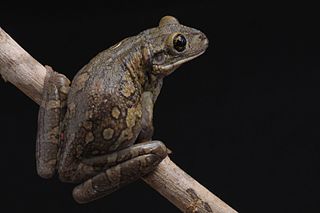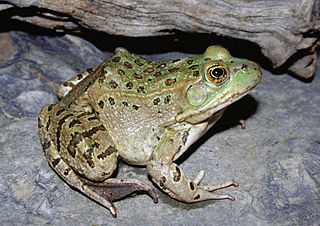
The South American sea lion, also called the southern sea lion and the Patagonian sea lion, is a sea lion found on the western and southeastern coasts of South America. It is the only member of the genus Otaria. The species is highly sexually dimorphic. Males have a large head and prominent mane. They mainly feed on fish and cephalopods and haul out on sand, gravel, rocky, or pebble beaches. In most populations, breeding males are both territorial and harem holding; they establish territories first and then try to herd females into them. The overall population of the species is considered stable, estimated at 265,000 animals.

River stingrays or freshwater stingrays are Neotropical freshwater fishes of the family Potamotrygonidae in the order Myliobatiformes, one of the four orders of batoids, cartilaginous fishes related to sharks. They are found in rivers in tropical and subtropical South America. A single marine genus, Styracura, of the tropical West Atlantic and East Pacific are also part of Potamotrygonidae. They are generally brownish, greyish or black, often with a mottled, speckled or spotted pattern, have disc widths ranging from 31 to 200 centimetres (1.0–6.6 ft) and venomous tail stingers. River stingrays feed on a wide range of smaller animals and the females give birth to live young. There are more than 35 species in five genera.
Rhinella bergi is a species of toads in the family Bufonidae that is found in Argentina, Brazil, and Paraguay. Its natural habitats are dry savanna, moist savanna, subtropical or tropical seasonally wet or flooded lowland grassland, freshwater marshes, intermittent freshwater marshes, arable land, pastureland, and ponds. It is threatened by habitat loss.
Rhinella ocellata is a species of toad in the family Bufonidae. It is endemic to Brazil. Its natural habitats are moist savanna, subtropical or tropical moist shrubland, subtropical or tropical high-altitude shrubland, rivers, intermittent rivers, freshwater marshes, and intermittent freshwater marshes. It is threatened by habitat loss.

Aplastodiscus leucopygius is a species of frog in the family Hylidae, endemic to Brazil. Its natural habitats are subtropical or tropical moist lowland forests, rivers, intermittent freshwater marshes, plantations, rural gardens, heavily degraded former forests, and irrigated land.
Dendropsophus cerradensis is a species of frogs in the family Hylidae.
Boana buriti is a species of frog in the family Hylidae endemic to Brazil. Its natural habitats are moist savanna, subtropical or tropical moist shrubland, freshwater marshes, and intermittent freshwater marshes. It is threatened by habitat loss.

The many-banded tree frog is a species of frog in the family Hylidae found in Brazil, French Guiana, Guyana, Suriname, and Venezuela. Its natural habitats are subtropical or tropical dry forests, subtropical or tropical moist lowland forests, moist savanna, rivers, freshwater lakes, freshwater marshes, pastureland, rural gardens, heavily degraded former forests, and canals and ditches.

Tornier's frog is a species of frog in the subfamily Pelodryadinae. It is endemic to Australia.

The Wotjulum frog is a species of frog in the subfamily Pelodryadinae. Its habitats are subtropical or tropical dry forests, subtropical or tropical moist lowland forests, subtropical or tropical swamps, rivers, intermittent rivers, swamps, freshwater lakes, freshwater marshes, intermittent freshwater marshes, and rocky areas.

Ololygon catharinae is a species of frog in the family Hylidae. It is endemic to Brazil. Its natural habitats are subtropical or tropical moist lowland forests, subtropical or tropical moist montane forests, rivers, freshwater marshes, and intermittent freshwater marshes. It is threatened by habitat loss.
Scinax maracaya is a species of frog in the family Hylidae. It is endemic to Brazil. Its natural habitats are moist savanna, freshwater marshes, and intermittent freshwater marshes. It is threatened by habitat loss.

The black-spotted casque-headed tree frog is a species of frog in the family Hylidae endemic to Brazil. Its natural habitats are subtropical or tropical moist lowland forests, subtropical or tropical moist shrubland, freshwater lakes, intermittent freshwater lakes, freshwater marshes, intermittent freshwater marshes, rural gardens, and heavily degraded former forests. It is threatened by habitat loss.
Hydrolaetare dantasi is a species of frog in the family Leptodactylidae. It is only known from the Amazon rainforest of Acre state in western Brazil, although it is likely that it has a wider distribution reaching Bolivia and Peru. Its natural habitats are tropical moist lowland forests, swamps, rivers, freshwater marshes, and intermittent freshwater marshes. It is potentially threatened by habitat loss.

The Chiricahua leopard frog is a species of frog in the family Ranidae, the true frogs.

Kenneth S. Norris Rancho Marino Reserve is part of the University of California Natural Reserve System. The reserve is located along the coast of San Luis Obispo County at the south end of the town of Cambria, California. It is named for Kenneth S. Norris, a University of California professor, renowned naturalist, and founder of the UC Natural Reserve System. It is operated by the university under a use agreement, as it is privately owned and funded. There is no public access.

Stylocheilus striatus is a species of sea hare found in the Indo-pacific region living from the intertidal zone to a depth of 30 metres. Common names include lined sea hare, blue ring sea hare and furry sea hare. Mature animals can reach sizes of up to 65 mm in length and are brown in colour with blue spots. Their diet mainly consists of blue algae. They play an important role in controlling toxic blooms of the cyanobacterium Lyngbya majuscula.
Hanak's dwarf bat or Hanak's pipistrelle is a species of bat only found in Cyrenaica, Libya and Crete, Greece.

Gyratrix is a genus of flatworms belonging to the family Polycystididae.

Typhloplanidae is a family of flatworms in the order Rhabdocoela.













